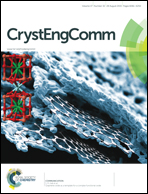Strong correlation of the growth mode and electrical properties of BiCuSeO single crystals with growth temperature
Abstract
In this paper, BiCuSeO single crystals are successfully grown by a flux method at different growth temperatures (690 °C, 730 °C and 775 °C). The crystal surface morphology, microstructure, chemical composition and electrical properties are systematically characterized. By changing the growth temperature, the growth mechanism evolution, from dislocation-driven spiral growth mode to two-dimensional layer-by-layer mode, is observed due to the different growth supersaturations. Simultaneously, the temperature-dependent resistance confirms the electrical property changes from semiconductor to metal. Chemical analysis proves that BiCuSeO crystals grown at higher temperatures (730 °C and 775 °C) are slightly non-stoichiometric. The present results demonstrate the possibility of modulating the crystal morphology and electrical properties of BiCuSeO by controlling the supersaturation. This method may be applicable to similar compounds (BiCuOCh (Ch = S, Te)).


 Please wait while we load your content...
Please wait while we load your content...